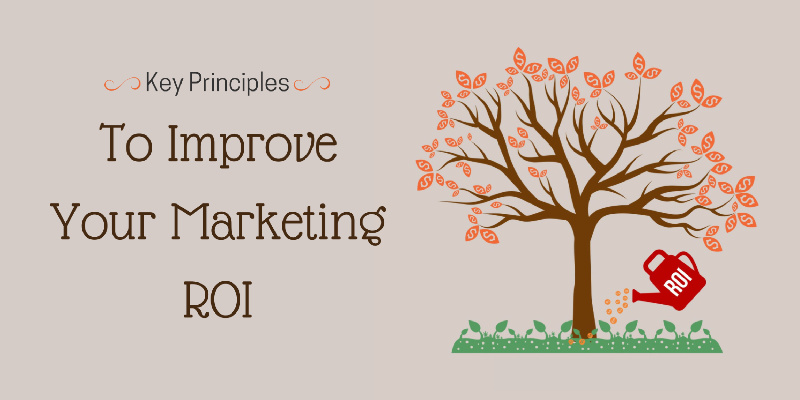In the world of business, your ROI is one of the most important areas that needs to be constantly monitored. In monitoring your ROI it tells you if your business is a profitable investment to place your time and energy into or if changes are needed. If you’ve found that your marketing ROI needs some improvement, but are unsure as to how to make this happen, this expert guide will give you the top key principles to improving your marketing ROI so you can see more profits in your pocket. But first…
What Determines A Good Marketing ROI?
Many people have their own idea about what a good marketing ROI is. So what determines a good ROI from a bad one? ROI is calculated by two primary metrics. These are the cost of doing something and the generated outcome from spending. It’s all about how much you get back in return for spending a dollar.
So What Counts As A Marketing Cost?
Marketing costs generally encompass a broad area depending on the marketing avenues you’re using. Some costs you may have include, but may not be limited to:
- Content production costs
- Media spend
- PPC spend
- Display ad clicks
- Traditional marketing costs
- Advertising agency fees
- + more
By adding all your marketing costs when calculating your ROI, you’ll be able to get a more accurate idea of how much you’re actually making. This will help you to work on improving your ROI. Let’s take a look now at the different things you can do to achieve a better ROI.
Best Practices To Improve Your ROI
1. Identify Your Core Metrics and Measure Your Marketing Effectiveness
To improve your marketing ROI, you first need to identify your core metrics and how effective your marketing efforts are in these areas. Generally, metrics related to ROI include:
- Sales
- Leads
- Traffic
It’s important to remember that not all traffic is created equal. If you send targeted traffic directly to your sales pages you will see a bigger improvement in your ROI than what you would if you were to send them to your home page or another page unrelated to the sales on your website.
So how do you measure your marketing effectiveness on your core metrics? What should you track in order to gain the best results? These include:
- Conversion Rate – Your conversion rate is the percentage of visitors that actively take action to reach the end goal of your business. This could be a sale, subscription, or download. If your conversion rate is lower than 2 percent, you will need to look into the different areas of your website or business which may be holding back a sale or distracting your potential customers from finishing the sales funnel.
- Bounce Rate – If your bounce rate is high then it means your website isn’t keeping your customers on your website. Areas of your website that may not be interesting to your audience can be found through A/B testing which will be covered later in the article.
- Unique Visitors – The number of unique visitors will also dictate whether your marketing efforts have been successful to what investment you’ll return. The number of visitors that will visit your website will vary depending on the industry sector, your company, and the content and marketing efforts you’re working with.
By working out your core metrics and measuring your marketing effectiveness, it can help you to change areas of your digital marketing campaign to increase your conversions and results for a higher ROI.
Measuring the ROI of you content in an inbound marketing campaign is often more challenging than measuring the ROI of paid traffic, because the cost distribution is different.
All of the cost is up-front with content marketing, with the benefits continuing for months, or even years after the initial investment, whereas paid advertising’s ROI stops as soon as you stop paying for it. Paid advertising is, however, much easier to track and measure right from the start.
[Editor’s note] Spokal clients can use the ROI analysis page to calculate the ROI of each blog post they write, as Spokal tracks all of this for you.
Want Help With Your Content Marketing?
 The 3 Pillars Guide Will Get You Focused on The Right Things - At The Right Time. Enter your email address to get it now
The 3 Pillars Guide Will Get You Focused on The Right Things - At The Right Time. Enter your email address to get it now
2. Use A/B Testing
A/B testing is a great way to compare different website and marketing elements to work out which new change your visitors like better. A/B tests work on changing one element of a marketing campaign or website and comparing it with the original.
So how long should you run an A/B test for? In retrospect, it really depends on your industry, your goals, and what you have to offer your customers. Every A/B test would be different to the next.
To gauge whether the new changes have been successful it comes down to running the test for a set period of time until there’s a clear winner. If you have one version that’s really making headway, move to that version and start over again. If you have a lot of traffic running through your website, it’s important to allow more leeway on the testing period for accurate results.
Which Elements Should You A/B Test?
There are many website and marketing campaign elements that could be A/B tested. These include:
- Headlines
- Website colours
- Call to actions
- Page layout and design
- Font type
- Landing page copy
- Navigation links
As you can see below, it shows two different versions of the same website with an image and title change.
A/B testing is a great way to secure important information and data to determine the best ways to improve and optimise your marketing funnel for a higher ROI. You can find out more about A/B testing here: https://www.youtube.com/watch?v=-Kh0xCKoNvU
3. Experiment With Different Campaign Channels
Another way to improve your ROI is by experimenting with different campaign channels to see which ones work best overall with your business and its customers. Some key channel areas to experiment with include, but isn’t limited to:
- Direct mail
- Email marketing
- Content marketing
- Video marketing
- Digital advertisements
- Social media marketing
- Mobile marketing
- + many more.
By narrowing down which campaign channels to use, based on what your customers and visitors like, you’ll have the potential to improve your ROI greatly. This will lead to more money being available to place into other areas of your business.
When running campaigns like content marketing, using specific tools such as Spokal will help to not only make you a better blogger but will help to improve your sales and profits for better ROI. Different marketing tools provide benefits for different marketing channels. You just have to know which ones to use in order to gain the best results overall.
4. Focus On Your Spending and Income
In order to really improve your ROI, you also need to focus on what you’re spending and what you’re getting in. It’s not uncommon for businesses to find out that they’re spending more on parts of their marketing that isn’t driving in the results and income they’re hoping for.
To work out which marketing channels aren’t working you simply need to look into the conversions, leads and profits you’re making from each marketing channel. You can ask yourself:
- Is it making the required conversions that you’re aiming for?
- Is it gaining a lot of interaction from your audience?
- Is it driving a lot of traffic back to your website?
- Has it contributed to your profits in the last 3 months?
When you’ve worked out which areas aren’t working in your digital marketing strategy, you can then look at cutting those avenues off. The money that you’ve been spending on these failing marketing channels can be placed into the channels that are working in your favour. As you grow your more profitable marketing avenues, you’ll have the potential to increase your marketing ROI greatly.
Conclusion
Improving your marketing ROI won’t happen overnight, however by making the right changes to your marketing efforts, your business has the potential to see growth in many areas including in your ROI. The more profits you get back from your spending, the more you’ll be able to expand your business and reap the rewards that you’re looking for. So are you going to start making changes to improve your ROI?
Author: Aaron Gray
Aaron Gray is a passionate digital marketing expert and the co-founder of Command Center. Command Center is the one place for people to manage and consolidate all their digital assets. The platform was designed for business owners and marketers to take action within the platform to improve sales, measure the ROI on all digital campaigns, and to deliver insights into complex data in simple to understand reports. Aaron’s goal is to help business and website owners take control of their online marketing and assets to be able to make smarter business decisions.




